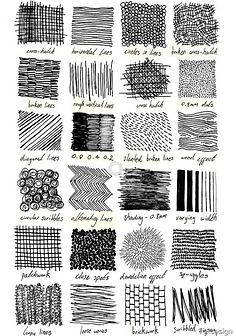How can we increase the realism of our drawings by capturing various surface textures and effects through our mark making?

Texture is the look and feel of a surface in an artwork, either real or implied.
Can you spot examples of different shading techniques applied in this drawing to capture different textures and surface effects?
How are the different marks expressive?
Image by the_avenue_art_studio
ASSIGNMENT PART A
Shading Techniques Handout
BLENDING / TONAL SHADING - smooth gradation of value

%20copy%20(2).png)
In your sketchbook title a page "Texture + Shading Techniques"
Write a definition for texture. Complete the shading handout for all 5 shading techniques and tape or glue it into your sketchbook.
HATCHING - parallel lines
%20copy%20(2).png)



CROSS HATCHING - parallel lines criss crossing
%20copy%20(2).png)

SCUMBLING - scribbled, gestural lines
%20copy%20(2).png)
STIPPLING- points / dots
%20copy%20(2).png)



ASSIGNMENT PART B
.


Warm Up
In your sketchbook:
Select 6 additional examples of shading / texture techniques and duplicate them in approximately 1" x 1" thumbnail boxes.
PRACTICE SHADING TEXTURES FROM LIFE.
SELECT ONE OBJECT FROM THE BOX - Determine which shading technique would best depict the surface texture. Identify brightest highlight/ white of paper, light values, mid tones, med dark values to darkest black values. Use the technique to shade the object with a range of values.

-
Spend a minute just looking at your object - identify the brightest highlight - midtones - darkest values.
-
VERY Lightly sketch the contours.
-
Develop the form through shading. Strive for 5-7 or more clear values.
-
Allow the values to create edges vs. outlining.
TONAL SHADING
HATCHING
CROSS-HATCHING
SCUMBLING
STIPPLING
